Critical Appraisal of a Qualitative Research Paper on Prescribing
VerifiedAdded on 2021/10/03
|12
|2822
|148
Report
AI Summary
This report presents a critical appraisal of the qualitative research paper "Beginners in prescribing practice: Experiences and perceptions of nurses and doctors" by Lim, North, and Shaw (2018). The assignment examines the research's focus on comparing the perceptions and experiences of nurses and doctors as they become prescribers, highlighting the importance of skills development and mentorship. The appraisal covers the research question, background, aim, methodology (a constructivist narrative method using a multiple case narrative approach), data collection methods (purposive sampling and in-depth interviews), data analysis techniques, and sample selection (26 participants from Auckland, New Zealand). The findings, which include themes of fear, personal drug lists, and reliance on senior prescribers, are evaluated for their relevance and validity. The report also discusses the ethical considerations, strengths, and weaknesses of the study, concluding with recommendations for future research and implications for practice, emphasizing the need for improved curricula for prescribing roles and the importance of addressing the challenges faced by novice prescribers. The report underscores the study's contribution to understanding the experiences of healthcare professionals in prescribing practice.
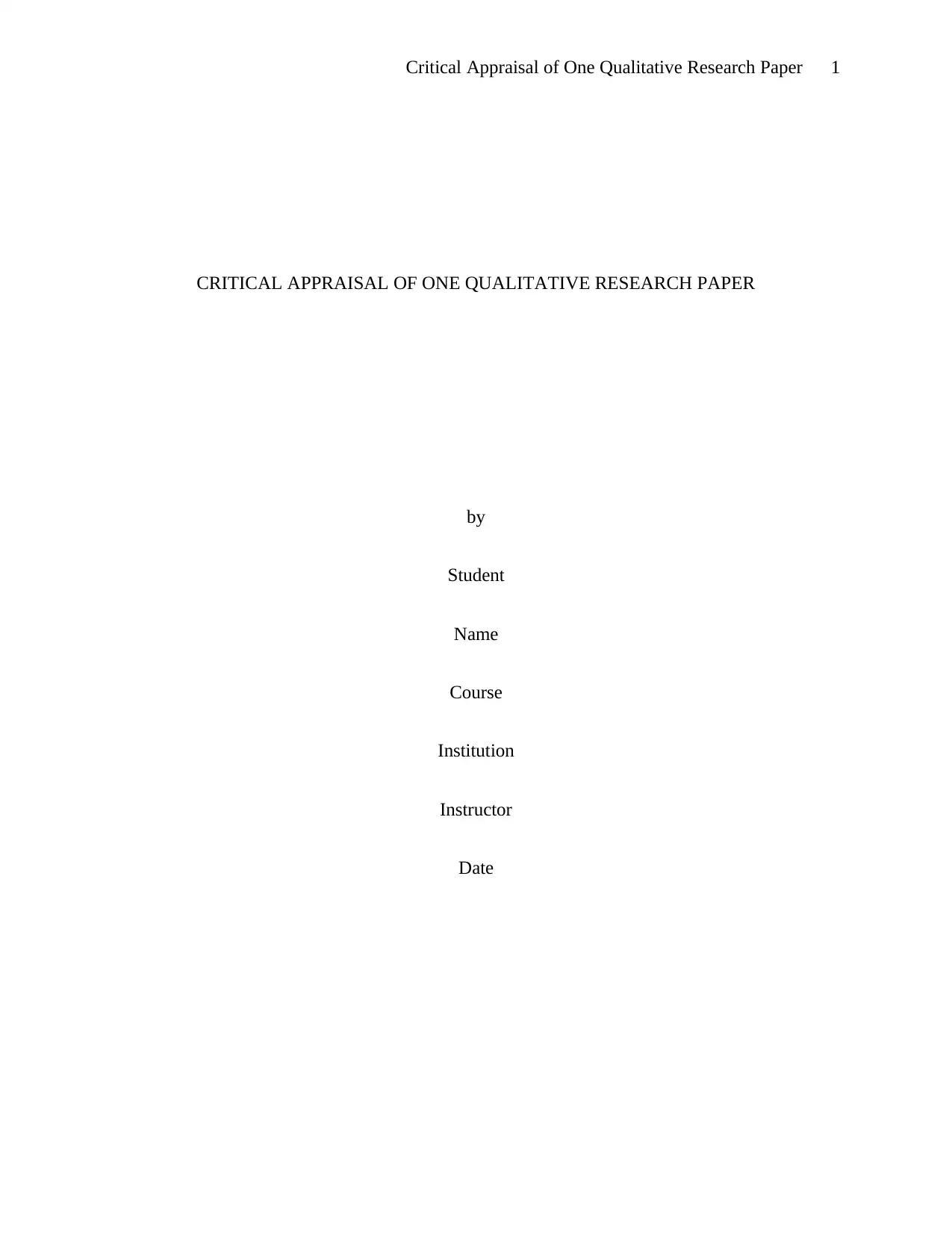
Critical Appraisal of One Qualitative Research Paper 1
CRITICAL APPRAISAL OF ONE QUALITATIVE RESEARCH PAPER
by
Student
Name
Course
Institution
Instructor
Date
CRITICAL APPRAISAL OF ONE QUALITATIVE RESEARCH PAPER
by
Student
Name
Course
Institution
Instructor
Date
Paraphrase This Document
Need a fresh take? Get an instant paraphrase of this document with our AI Paraphraser
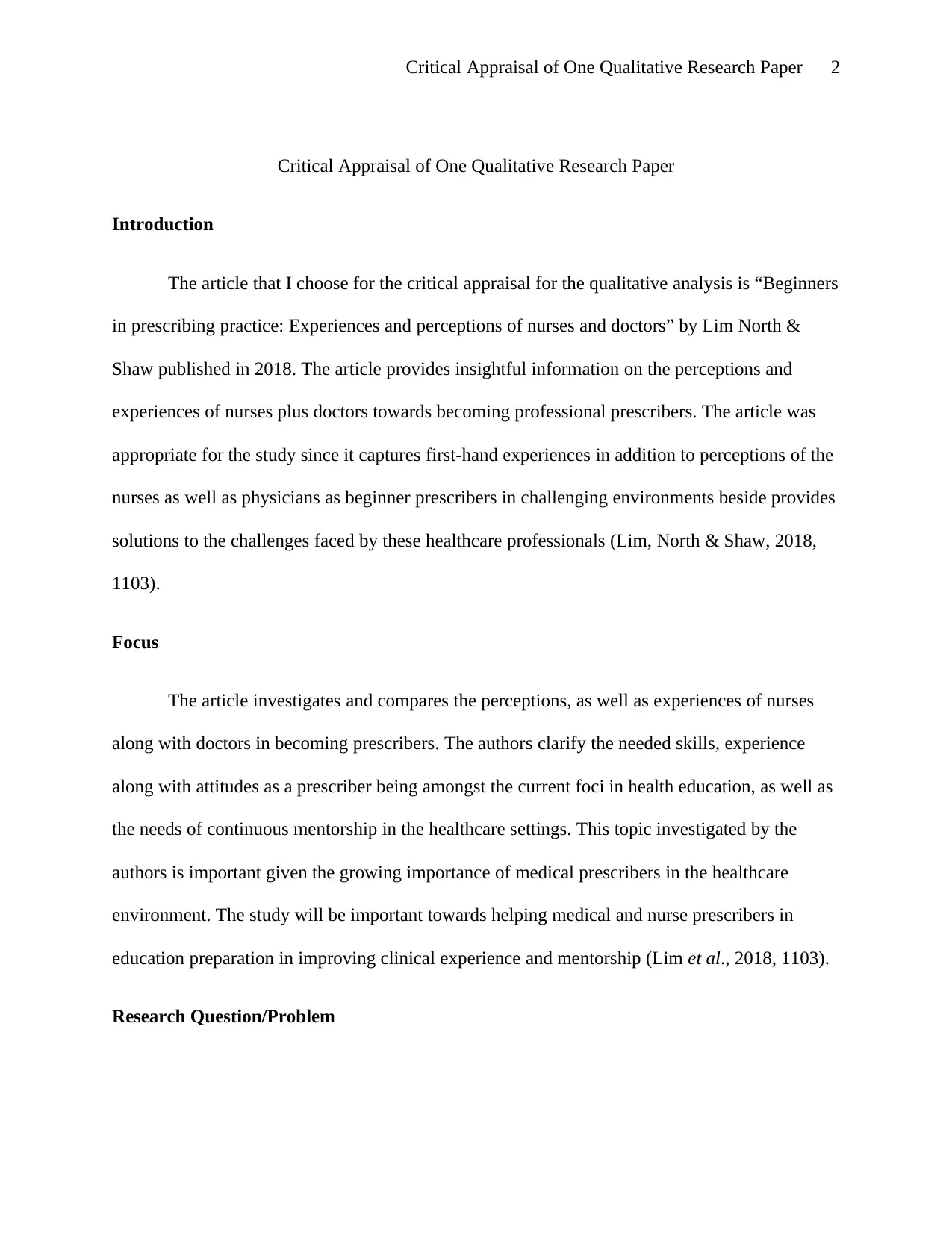
Critical Appraisal of One Qualitative Research Paper 2
Critical Appraisal of One Qualitative Research Paper
Introduction
The article that I choose for the critical appraisal for the qualitative analysis is “Beginners
in prescribing practice: Experiences and perceptions of nurses and doctors” by Lim North &
Shaw published in 2018. The article provides insightful information on the perceptions and
experiences of nurses plus doctors towards becoming professional prescribers. The article was
appropriate for the study since it captures first-hand experiences in addition to perceptions of the
nurses as well as physicians as beginner prescribers in challenging environments beside provides
solutions to the challenges faced by these healthcare professionals (Lim, North & Shaw, 2018,
1103).
Focus
The article investigates and compares the perceptions, as well as experiences of nurses
along with doctors in becoming prescribers. The authors clarify the needed skills, experience
along with attitudes as a prescriber being amongst the current foci in health education, as well as
the needs of continuous mentorship in the healthcare settings. This topic investigated by the
authors is important given the growing importance of medical prescribers in the healthcare
environment. The study will be important towards helping medical and nurse prescribers in
education preparation in improving clinical experience and mentorship (Lim et al., 2018, 1103).
Research Question/Problem
Critical Appraisal of One Qualitative Research Paper
Introduction
The article that I choose for the critical appraisal for the qualitative analysis is “Beginners
in prescribing practice: Experiences and perceptions of nurses and doctors” by Lim North &
Shaw published in 2018. The article provides insightful information on the perceptions and
experiences of nurses plus doctors towards becoming professional prescribers. The article was
appropriate for the study since it captures first-hand experiences in addition to perceptions of the
nurses as well as physicians as beginner prescribers in challenging environments beside provides
solutions to the challenges faced by these healthcare professionals (Lim, North & Shaw, 2018,
1103).
Focus
The article investigates and compares the perceptions, as well as experiences of nurses
along with doctors in becoming prescribers. The authors clarify the needed skills, experience
along with attitudes as a prescriber being amongst the current foci in health education, as well as
the needs of continuous mentorship in the healthcare settings. This topic investigated by the
authors is important given the growing importance of medical prescribers in the healthcare
environment. The study will be important towards helping medical and nurse prescribers in
education preparation in improving clinical experience and mentorship (Lim et al., 2018, 1103).
Research Question/Problem
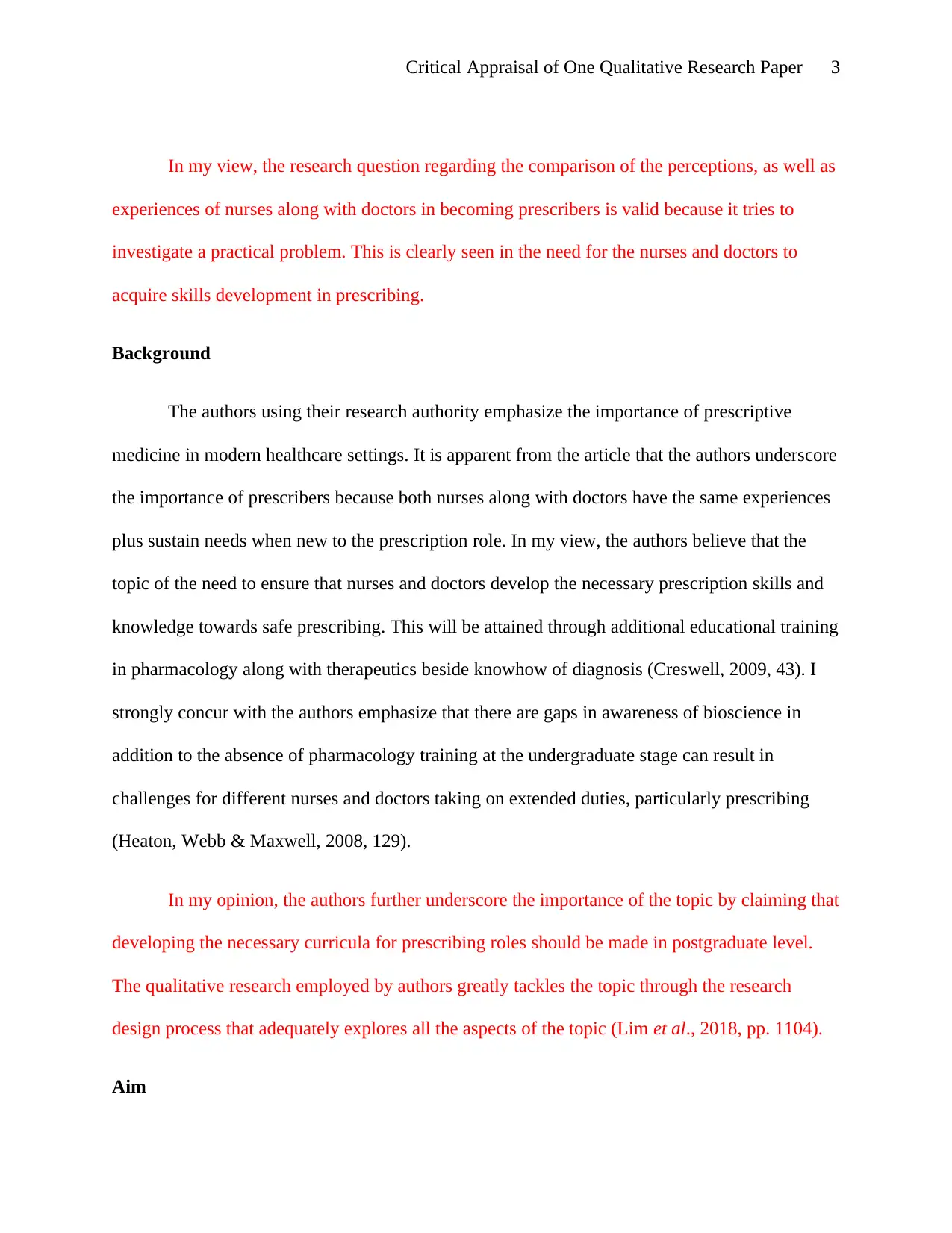
Critical Appraisal of One Qualitative Research Paper 3
In my view, the research question regarding the comparison of the perceptions, as well as
experiences of nurses along with doctors in becoming prescribers is valid because it tries to
investigate a practical problem. This is clearly seen in the need for the nurses and doctors to
acquire skills development in prescribing.
Background
The authors using their research authority emphasize the importance of prescriptive
medicine in modern healthcare settings. It is apparent from the article that the authors underscore
the importance of prescribers because both nurses along with doctors have the same experiences
plus sustain needs when new to the prescription role. In my view, the authors believe that the
topic of the need to ensure that nurses and doctors develop the necessary prescription skills and
knowledge towards safe prescribing. This will be attained through additional educational training
in pharmacology along with therapeutics beside knowhow of diagnosis (Creswell, 2009, 43). I
strongly concur with the authors emphasize that there are gaps in awareness of bioscience in
addition to the absence of pharmacology training at the undergraduate stage can result in
challenges for different nurses and doctors taking on extended duties, particularly prescribing
(Heaton, Webb & Maxwell, 2008, 129).
In my opinion, the authors further underscore the importance of the topic by claiming that
developing the necessary curricula for prescribing roles should be made in postgraduate level.
The qualitative research employed by authors greatly tackles the topic through the research
design process that adequately explores all the aspects of the topic (Lim et al., 2018, pp. 1104).
Aim
In my view, the research question regarding the comparison of the perceptions, as well as
experiences of nurses along with doctors in becoming prescribers is valid because it tries to
investigate a practical problem. This is clearly seen in the need for the nurses and doctors to
acquire skills development in prescribing.
Background
The authors using their research authority emphasize the importance of prescriptive
medicine in modern healthcare settings. It is apparent from the article that the authors underscore
the importance of prescribers because both nurses along with doctors have the same experiences
plus sustain needs when new to the prescription role. In my view, the authors believe that the
topic of the need to ensure that nurses and doctors develop the necessary prescription skills and
knowledge towards safe prescribing. This will be attained through additional educational training
in pharmacology along with therapeutics beside knowhow of diagnosis (Creswell, 2009, 43). I
strongly concur with the authors emphasize that there are gaps in awareness of bioscience in
addition to the absence of pharmacology training at the undergraduate stage can result in
challenges for different nurses and doctors taking on extended duties, particularly prescribing
(Heaton, Webb & Maxwell, 2008, 129).
In my opinion, the authors further underscore the importance of the topic by claiming that
developing the necessary curricula for prescribing roles should be made in postgraduate level.
The qualitative research employed by authors greatly tackles the topic through the research
design process that adequately explores all the aspects of the topic (Lim et al., 2018, pp. 1104).
Aim
⊘ This is a preview!⊘
Do you want full access?
Subscribe today to unlock all pages.

Trusted by 1+ million students worldwide
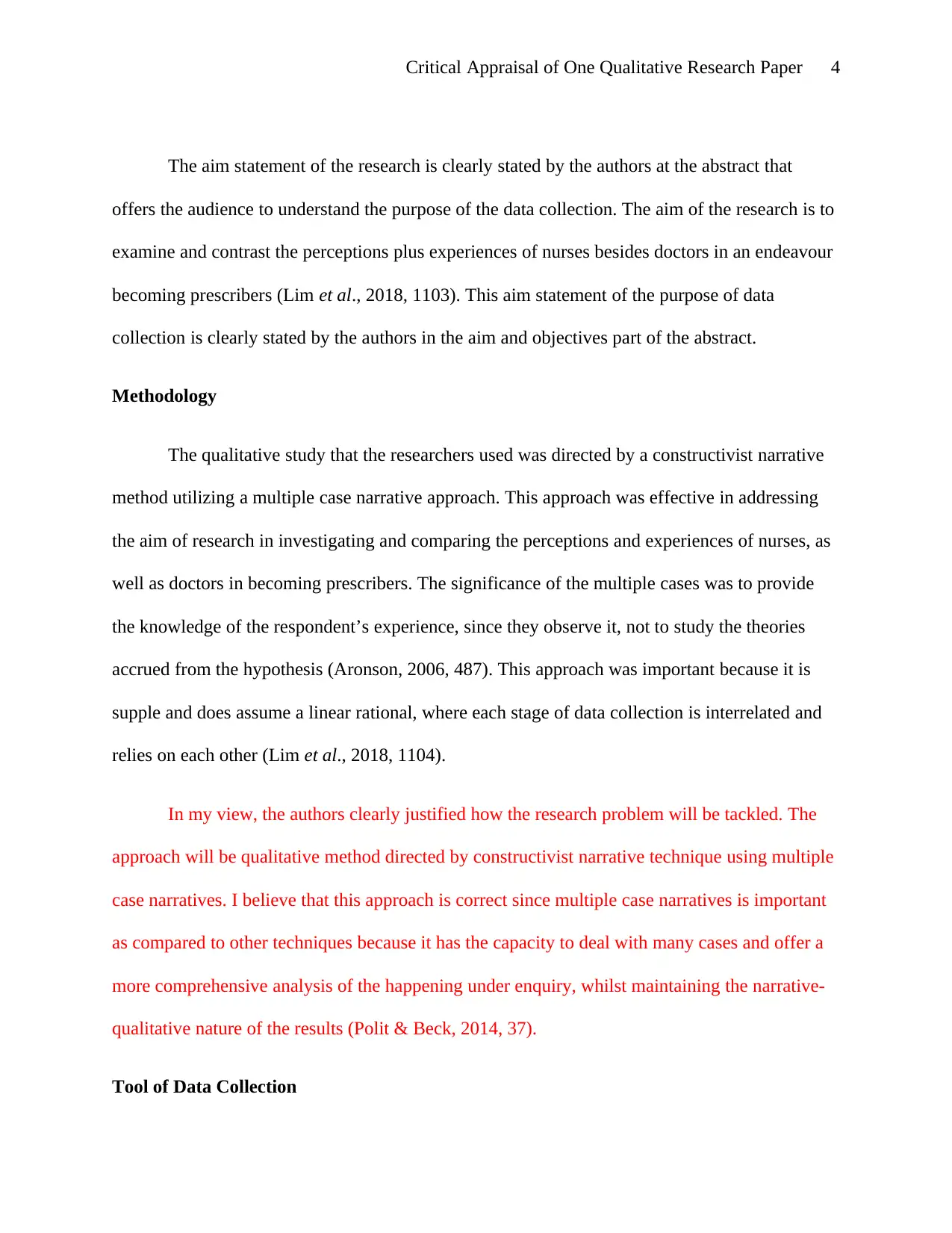
Critical Appraisal of One Qualitative Research Paper 4
The aim statement of the research is clearly stated by the authors at the abstract that
offers the audience to understand the purpose of the data collection. The aim of the research is to
examine and contrast the perceptions plus experiences of nurses besides doctors in an endeavour
becoming prescribers (Lim et al., 2018, 1103). This aim statement of the purpose of data
collection is clearly stated by the authors in the aim and objectives part of the abstract.
Methodology
The qualitative study that the researchers used was directed by a constructivist narrative
method utilizing a multiple case narrative approach. This approach was effective in addressing
the aim of research in investigating and comparing the perceptions and experiences of nurses, as
well as doctors in becoming prescribers. The significance of the multiple cases was to provide
the knowledge of the respondent’s experience, since they observe it, not to study the theories
accrued from the hypothesis (Aronson, 2006, 487). This approach was important because it is
supple and does assume a linear rational, where each stage of data collection is interrelated and
relies on each other (Lim et al., 2018, 1104).
In my view, the authors clearly justified how the research problem will be tackled. The
approach will be qualitative method directed by constructivist narrative technique using multiple
case narratives. I believe that this approach is correct since multiple case narratives is important
as compared to other techniques because it has the capacity to deal with many cases and offer a
more comprehensive analysis of the happening under enquiry, whilst maintaining the narrative-
qualitative nature of the results (Polit & Beck, 2014, 37).
Tool of Data Collection
The aim statement of the research is clearly stated by the authors at the abstract that
offers the audience to understand the purpose of the data collection. The aim of the research is to
examine and contrast the perceptions plus experiences of nurses besides doctors in an endeavour
becoming prescribers (Lim et al., 2018, 1103). This aim statement of the purpose of data
collection is clearly stated by the authors in the aim and objectives part of the abstract.
Methodology
The qualitative study that the researchers used was directed by a constructivist narrative
method utilizing a multiple case narrative approach. This approach was effective in addressing
the aim of research in investigating and comparing the perceptions and experiences of nurses, as
well as doctors in becoming prescribers. The significance of the multiple cases was to provide
the knowledge of the respondent’s experience, since they observe it, not to study the theories
accrued from the hypothesis (Aronson, 2006, 487). This approach was important because it is
supple and does assume a linear rational, where each stage of data collection is interrelated and
relies on each other (Lim et al., 2018, 1104).
In my view, the authors clearly justified how the research problem will be tackled. The
approach will be qualitative method directed by constructivist narrative technique using multiple
case narratives. I believe that this approach is correct since multiple case narratives is important
as compared to other techniques because it has the capacity to deal with many cases and offer a
more comprehensive analysis of the happening under enquiry, whilst maintaining the narrative-
qualitative nature of the results (Polit & Beck, 2014, 37).
Tool of Data Collection
Paraphrase This Document
Need a fresh take? Get an instant paraphrase of this document with our AI Paraphraser
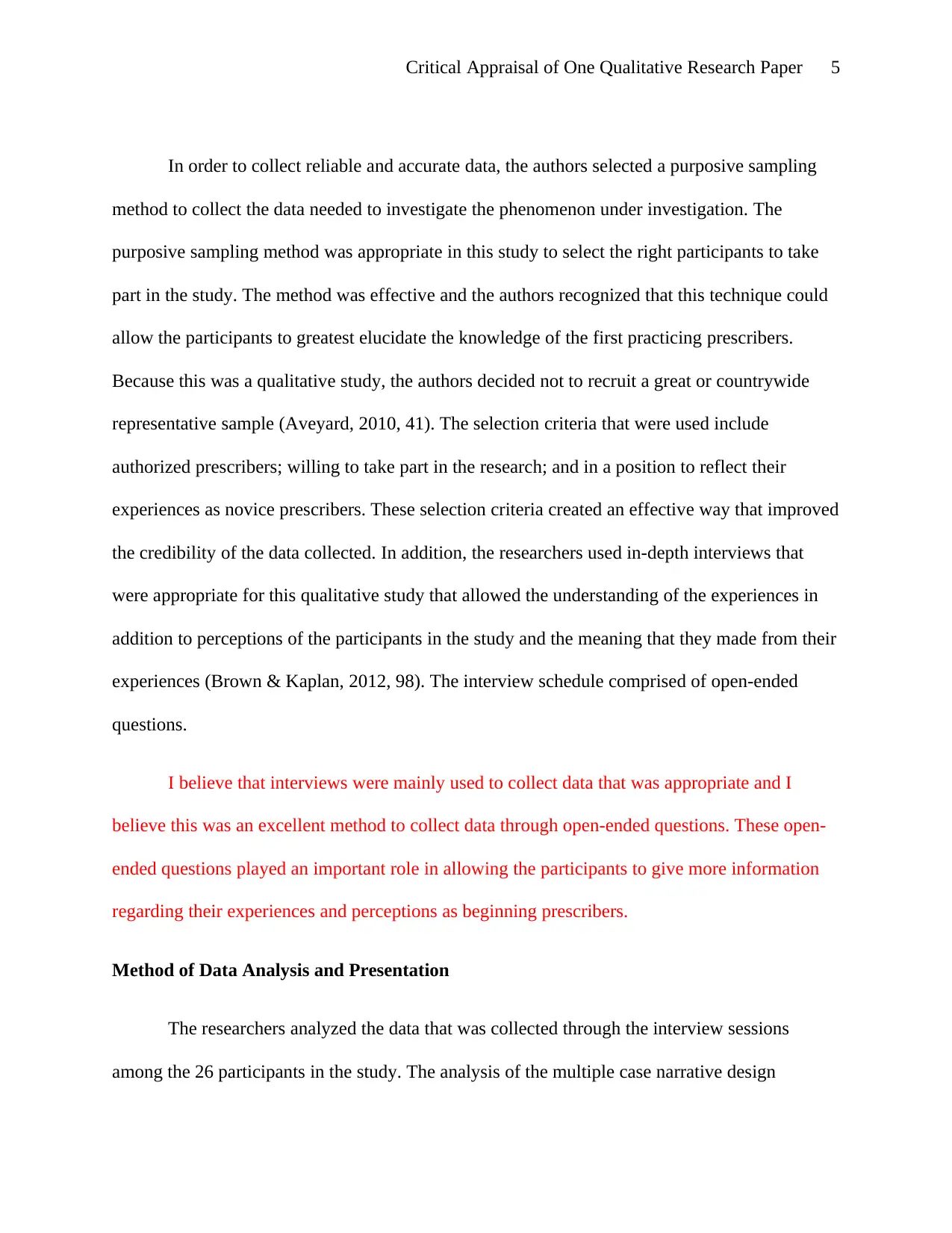
Critical Appraisal of One Qualitative Research Paper 5
In order to collect reliable and accurate data, the authors selected a purposive sampling
method to collect the data needed to investigate the phenomenon under investigation. The
purposive sampling method was appropriate in this study to select the right participants to take
part in the study. The method was effective and the authors recognized that this technique could
allow the participants to greatest elucidate the knowledge of the first practicing prescribers.
Because this was a qualitative study, the authors decided not to recruit a great or countrywide
representative sample (Aveyard, 2010, 41). The selection criteria that were used include
authorized prescribers; willing to take part in the research; and in a position to reflect their
experiences as novice prescribers. These selection criteria created an effective way that improved
the credibility of the data collected. In addition, the researchers used in-depth interviews that
were appropriate for this qualitative study that allowed the understanding of the experiences in
addition to perceptions of the participants in the study and the meaning that they made from their
experiences (Brown & Kaplan, 2012, 98). The interview schedule comprised of open-ended
questions.
I believe that interviews were mainly used to collect data that was appropriate and I
believe this was an excellent method to collect data through open-ended questions. These open-
ended questions played an important role in allowing the participants to give more information
regarding their experiences and perceptions as beginning prescribers.
Method of Data Analysis and Presentation
The researchers analyzed the data that was collected through the interview sessions
among the 26 participants in the study. The analysis of the multiple case narrative design
In order to collect reliable and accurate data, the authors selected a purposive sampling
method to collect the data needed to investigate the phenomenon under investigation. The
purposive sampling method was appropriate in this study to select the right participants to take
part in the study. The method was effective and the authors recognized that this technique could
allow the participants to greatest elucidate the knowledge of the first practicing prescribers.
Because this was a qualitative study, the authors decided not to recruit a great or countrywide
representative sample (Aveyard, 2010, 41). The selection criteria that were used include
authorized prescribers; willing to take part in the research; and in a position to reflect their
experiences as novice prescribers. These selection criteria created an effective way that improved
the credibility of the data collected. In addition, the researchers used in-depth interviews that
were appropriate for this qualitative study that allowed the understanding of the experiences in
addition to perceptions of the participants in the study and the meaning that they made from their
experiences (Brown & Kaplan, 2012, 98). The interview schedule comprised of open-ended
questions.
I believe that interviews were mainly used to collect data that was appropriate and I
believe this was an excellent method to collect data through open-ended questions. These open-
ended questions played an important role in allowing the participants to give more information
regarding their experiences and perceptions as beginning prescribers.
Method of Data Analysis and Presentation
The researchers analyzed the data that was collected through the interview sessions
among the 26 participants in the study. The analysis of the multiple case narrative design
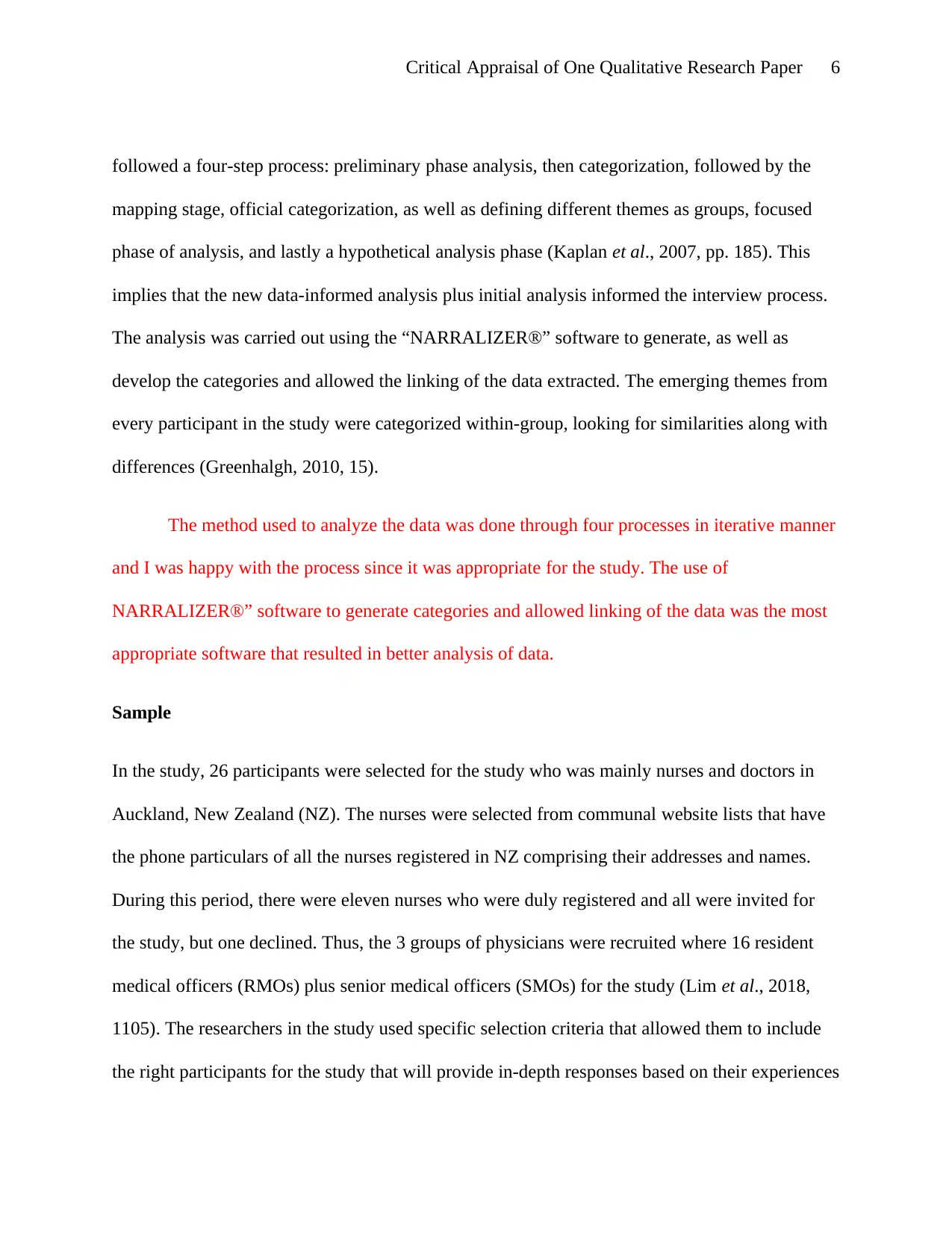
Critical Appraisal of One Qualitative Research Paper 6
followed a four-step process: preliminary phase analysis, then categorization, followed by the
mapping stage, official categorization, as well as defining different themes as groups, focused
phase of analysis, and lastly a hypothetical analysis phase (Kaplan et al., 2007, pp. 185). This
implies that the new data-informed analysis plus initial analysis informed the interview process.
The analysis was carried out using the “NARRALIZER®” software to generate, as well as
develop the categories and allowed the linking of the data extracted. The emerging themes from
every participant in the study were categorized within-group, looking for similarities along with
differences (Greenhalgh, 2010, 15).
The method used to analyze the data was done through four processes in iterative manner
and I was happy with the process since it was appropriate for the study. The use of
NARRALIZER®” software to generate categories and allowed linking of the data was the most
appropriate software that resulted in better analysis of data.
Sample
In the study, 26 participants were selected for the study who was mainly nurses and doctors in
Auckland, New Zealand (NZ). The nurses were selected from communal website lists that have
the phone particulars of all the nurses registered in NZ comprising their addresses and names.
During this period, there were eleven nurses who were duly registered and all were invited for
the study, but one declined. Thus, the 3 groups of physicians were recruited where 16 resident
medical officers (RMOs) plus senior medical officers (SMOs) for the study (Lim et al., 2018,
1105). The researchers in the study used specific selection criteria that allowed them to include
the right participants for the study that will provide in-depth responses based on their experiences
followed a four-step process: preliminary phase analysis, then categorization, followed by the
mapping stage, official categorization, as well as defining different themes as groups, focused
phase of analysis, and lastly a hypothetical analysis phase (Kaplan et al., 2007, pp. 185). This
implies that the new data-informed analysis plus initial analysis informed the interview process.
The analysis was carried out using the “NARRALIZER®” software to generate, as well as
develop the categories and allowed the linking of the data extracted. The emerging themes from
every participant in the study were categorized within-group, looking for similarities along with
differences (Greenhalgh, 2010, 15).
The method used to analyze the data was done through four processes in iterative manner
and I was happy with the process since it was appropriate for the study. The use of
NARRALIZER®” software to generate categories and allowed linking of the data was the most
appropriate software that resulted in better analysis of data.
Sample
In the study, 26 participants were selected for the study who was mainly nurses and doctors in
Auckland, New Zealand (NZ). The nurses were selected from communal website lists that have
the phone particulars of all the nurses registered in NZ comprising their addresses and names.
During this period, there were eleven nurses who were duly registered and all were invited for
the study, but one declined. Thus, the 3 groups of physicians were recruited where 16 resident
medical officers (RMOs) plus senior medical officers (SMOs) for the study (Lim et al., 2018,
1105). The researchers in the study used specific selection criteria that allowed them to include
the right participants for the study that will provide in-depth responses based on their experiences
⊘ This is a preview!⊘
Do you want full access?
Subscribe today to unlock all pages.

Trusted by 1+ million students worldwide
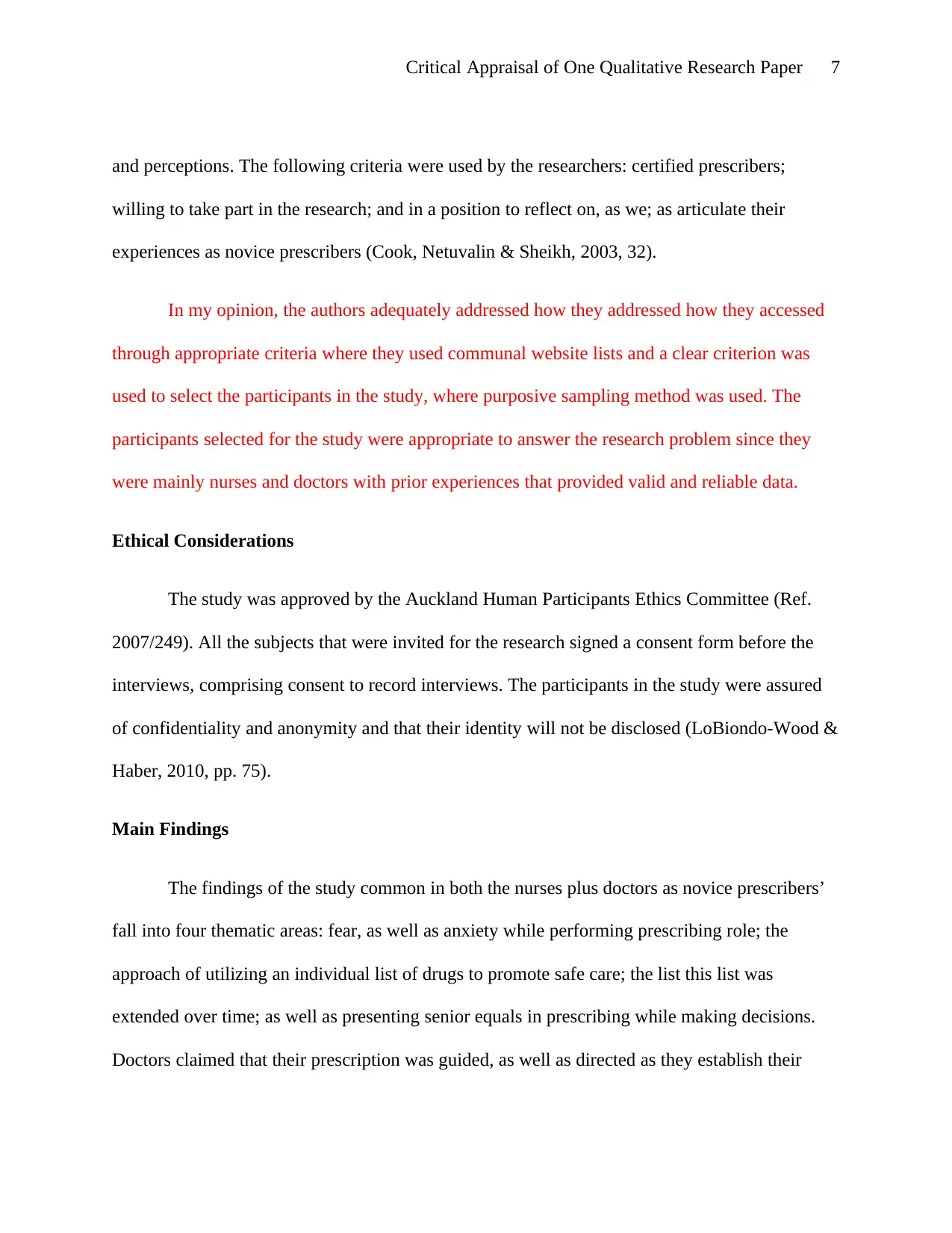
Critical Appraisal of One Qualitative Research Paper 7
and perceptions. The following criteria were used by the researchers: certified prescribers;
willing to take part in the research; and in a position to reflect on, as we; as articulate their
experiences as novice prescribers (Cook, Netuvalin & Sheikh, 2003, 32).
In my opinion, the authors adequately addressed how they addressed how they accessed
through appropriate criteria where they used communal website lists and a clear criterion was
used to select the participants in the study, where purposive sampling method was used. The
participants selected for the study were appropriate to answer the research problem since they
were mainly nurses and doctors with prior experiences that provided valid and reliable data.
Ethical Considerations
The study was approved by the Auckland Human Participants Ethics Committee (Ref.
2007/249). All the subjects that were invited for the research signed a consent form before the
interviews, comprising consent to record interviews. The participants in the study were assured
of confidentiality and anonymity and that their identity will not be disclosed (LoBiondo-Wood &
Haber, 2010, pp. 75).
Main Findings
The findings of the study common in both the nurses plus doctors as novice prescribers’
fall into four thematic areas: fear, as well as anxiety while performing prescribing role; the
approach of utilizing an individual list of drugs to promote safe care; the list this list was
extended over time; as well as presenting senior equals in prescribing while making decisions.
Doctors claimed that their prescription was guided, as well as directed as they establish their
and perceptions. The following criteria were used by the researchers: certified prescribers;
willing to take part in the research; and in a position to reflect on, as we; as articulate their
experiences as novice prescribers (Cook, Netuvalin & Sheikh, 2003, 32).
In my opinion, the authors adequately addressed how they addressed how they accessed
through appropriate criteria where they used communal website lists and a clear criterion was
used to select the participants in the study, where purposive sampling method was used. The
participants selected for the study were appropriate to answer the research problem since they
were mainly nurses and doctors with prior experiences that provided valid and reliable data.
Ethical Considerations
The study was approved by the Auckland Human Participants Ethics Committee (Ref.
2007/249). All the subjects that were invited for the research signed a consent form before the
interviews, comprising consent to record interviews. The participants in the study were assured
of confidentiality and anonymity and that their identity will not be disclosed (LoBiondo-Wood &
Haber, 2010, pp. 75).
Main Findings
The findings of the study common in both the nurses plus doctors as novice prescribers’
fall into four thematic areas: fear, as well as anxiety while performing prescribing role; the
approach of utilizing an individual list of drugs to promote safe care; the list this list was
extended over time; as well as presenting senior equals in prescribing while making decisions.
Doctors claimed that their prescription was guided, as well as directed as they establish their
Paraphrase This Document
Need a fresh take? Get an instant paraphrase of this document with our AI Paraphraser
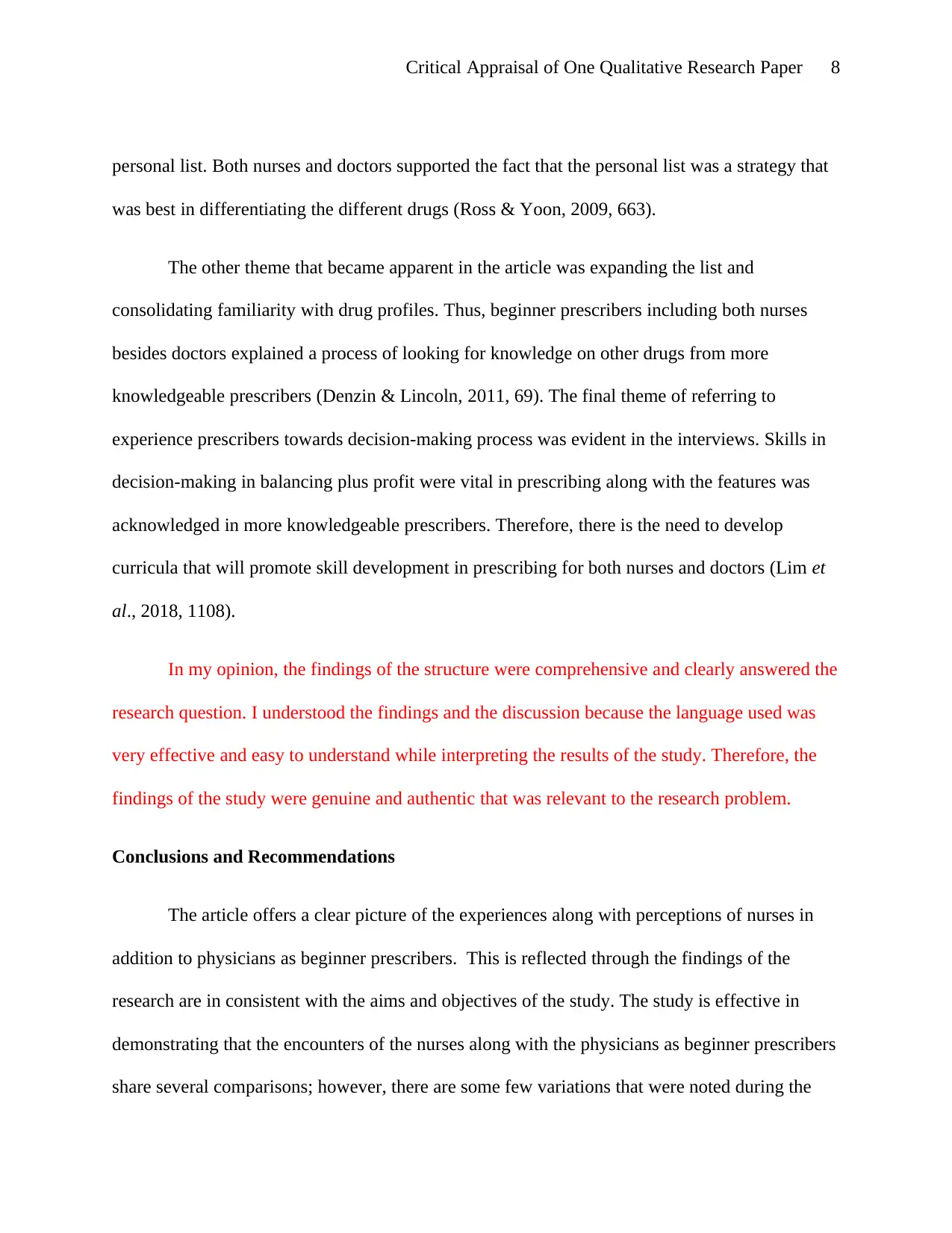
Critical Appraisal of One Qualitative Research Paper 8
personal list. Both nurses and doctors supported the fact that the personal list was a strategy that
was best in differentiating the different drugs (Ross & Yoon, 2009, 663).
The other theme that became apparent in the article was expanding the list and
consolidating familiarity with drug profiles. Thus, beginner prescribers including both nurses
besides doctors explained a process of looking for knowledge on other drugs from more
knowledgeable prescribers (Denzin & Lincoln, 2011, 69). The final theme of referring to
experience prescribers towards decision-making process was evident in the interviews. Skills in
decision-making in balancing plus profit were vital in prescribing along with the features was
acknowledged in more knowledgeable prescribers. Therefore, there is the need to develop
curricula that will promote skill development in prescribing for both nurses and doctors (Lim et
al., 2018, 1108).
In my opinion, the findings of the structure were comprehensive and clearly answered the
research question. I understood the findings and the discussion because the language used was
very effective and easy to understand while interpreting the results of the study. Therefore, the
findings of the study were genuine and authentic that was relevant to the research problem.
Conclusions and Recommendations
The article offers a clear picture of the experiences along with perceptions of nurses in
addition to physicians as beginner prescribers. This is reflected through the findings of the
research are in consistent with the aims and objectives of the study. The study is effective in
demonstrating that the encounters of the nurses along with the physicians as beginner prescribers
share several comparisons; however, there are some few variations that were noted during the
personal list. Both nurses and doctors supported the fact that the personal list was a strategy that
was best in differentiating the different drugs (Ross & Yoon, 2009, 663).
The other theme that became apparent in the article was expanding the list and
consolidating familiarity with drug profiles. Thus, beginner prescribers including both nurses
besides doctors explained a process of looking for knowledge on other drugs from more
knowledgeable prescribers (Denzin & Lincoln, 2011, 69). The final theme of referring to
experience prescribers towards decision-making process was evident in the interviews. Skills in
decision-making in balancing plus profit were vital in prescribing along with the features was
acknowledged in more knowledgeable prescribers. Therefore, there is the need to develop
curricula that will promote skill development in prescribing for both nurses and doctors (Lim et
al., 2018, 1108).
In my opinion, the findings of the structure were comprehensive and clearly answered the
research question. I understood the findings and the discussion because the language used was
very effective and easy to understand while interpreting the results of the study. Therefore, the
findings of the study were genuine and authentic that was relevant to the research problem.
Conclusions and Recommendations
The article offers a clear picture of the experiences along with perceptions of nurses in
addition to physicians as beginner prescribers. This is reflected through the findings of the
research are in consistent with the aims and objectives of the study. The study is effective in
demonstrating that the encounters of the nurses along with the physicians as beginner prescribers
share several comparisons; however, there are some few variations that were noted during the
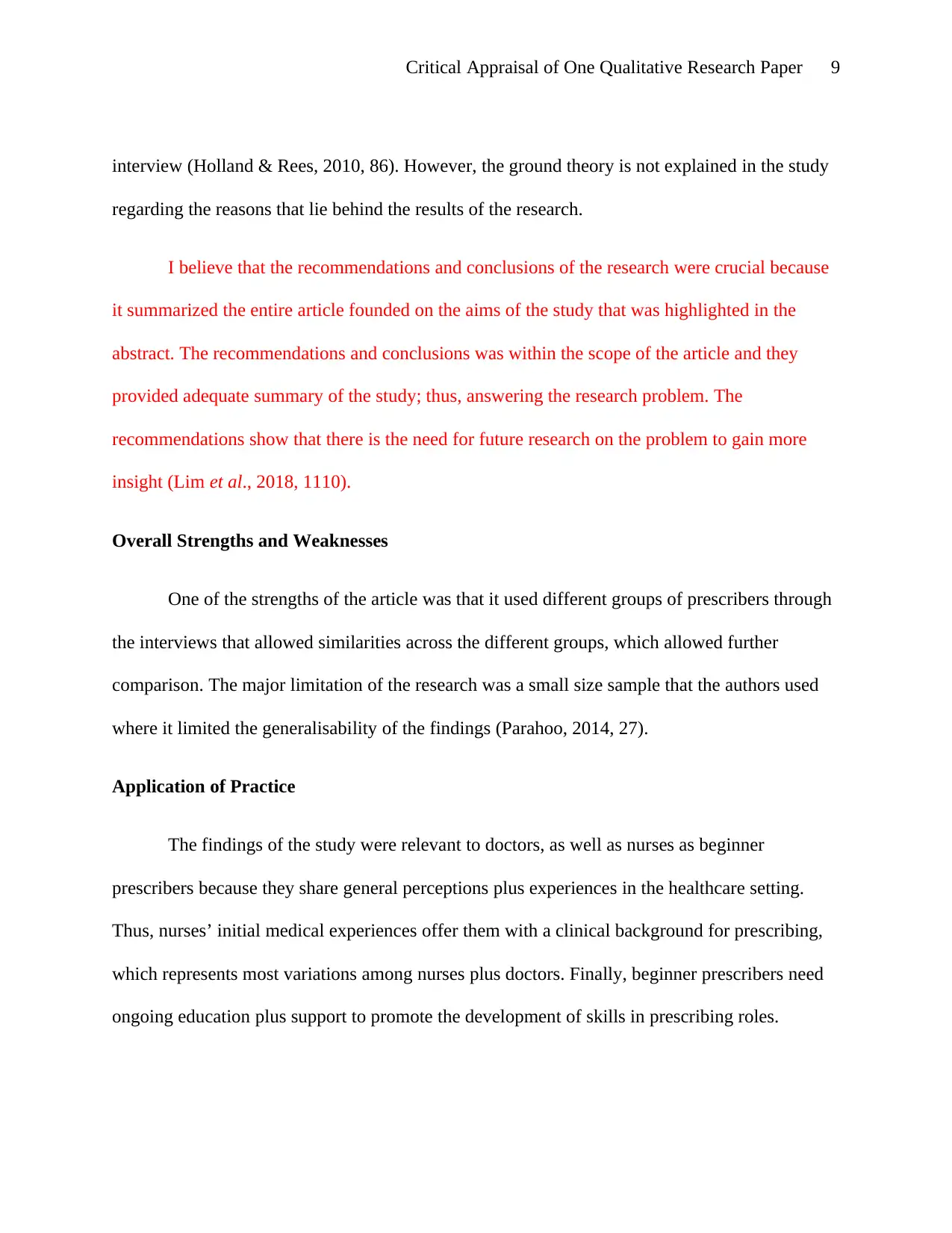
Critical Appraisal of One Qualitative Research Paper 9
interview (Holland & Rees, 2010, 86). However, the ground theory is not explained in the study
regarding the reasons that lie behind the results of the research.
I believe that the recommendations and conclusions of the research were crucial because
it summarized the entire article founded on the aims of the study that was highlighted in the
abstract. The recommendations and conclusions was within the scope of the article and they
provided adequate summary of the study; thus, answering the research problem. The
recommendations show that there is the need for future research on the problem to gain more
insight (Lim et al., 2018, 1110).
Overall Strengths and Weaknesses
One of the strengths of the article was that it used different groups of prescribers through
the interviews that allowed similarities across the different groups, which allowed further
comparison. The major limitation of the research was a small size sample that the authors used
where it limited the generalisability of the findings (Parahoo, 2014, 27).
Application of Practice
The findings of the study were relevant to doctors, as well as nurses as beginner
prescribers because they share general perceptions plus experiences in the healthcare setting.
Thus, nurses’ initial medical experiences offer them with a clinical background for prescribing,
which represents most variations among nurses plus doctors. Finally, beginner prescribers need
ongoing education plus support to promote the development of skills in prescribing roles.
interview (Holland & Rees, 2010, 86). However, the ground theory is not explained in the study
regarding the reasons that lie behind the results of the research.
I believe that the recommendations and conclusions of the research were crucial because
it summarized the entire article founded on the aims of the study that was highlighted in the
abstract. The recommendations and conclusions was within the scope of the article and they
provided adequate summary of the study; thus, answering the research problem. The
recommendations show that there is the need for future research on the problem to gain more
insight (Lim et al., 2018, 1110).
Overall Strengths and Weaknesses
One of the strengths of the article was that it used different groups of prescribers through
the interviews that allowed similarities across the different groups, which allowed further
comparison. The major limitation of the research was a small size sample that the authors used
where it limited the generalisability of the findings (Parahoo, 2014, 27).
Application of Practice
The findings of the study were relevant to doctors, as well as nurses as beginner
prescribers because they share general perceptions plus experiences in the healthcare setting.
Thus, nurses’ initial medical experiences offer them with a clinical background for prescribing,
which represents most variations among nurses plus doctors. Finally, beginner prescribers need
ongoing education plus support to promote the development of skills in prescribing roles.
⊘ This is a preview!⊘
Do you want full access?
Subscribe today to unlock all pages.

Trusted by 1+ million students worldwide
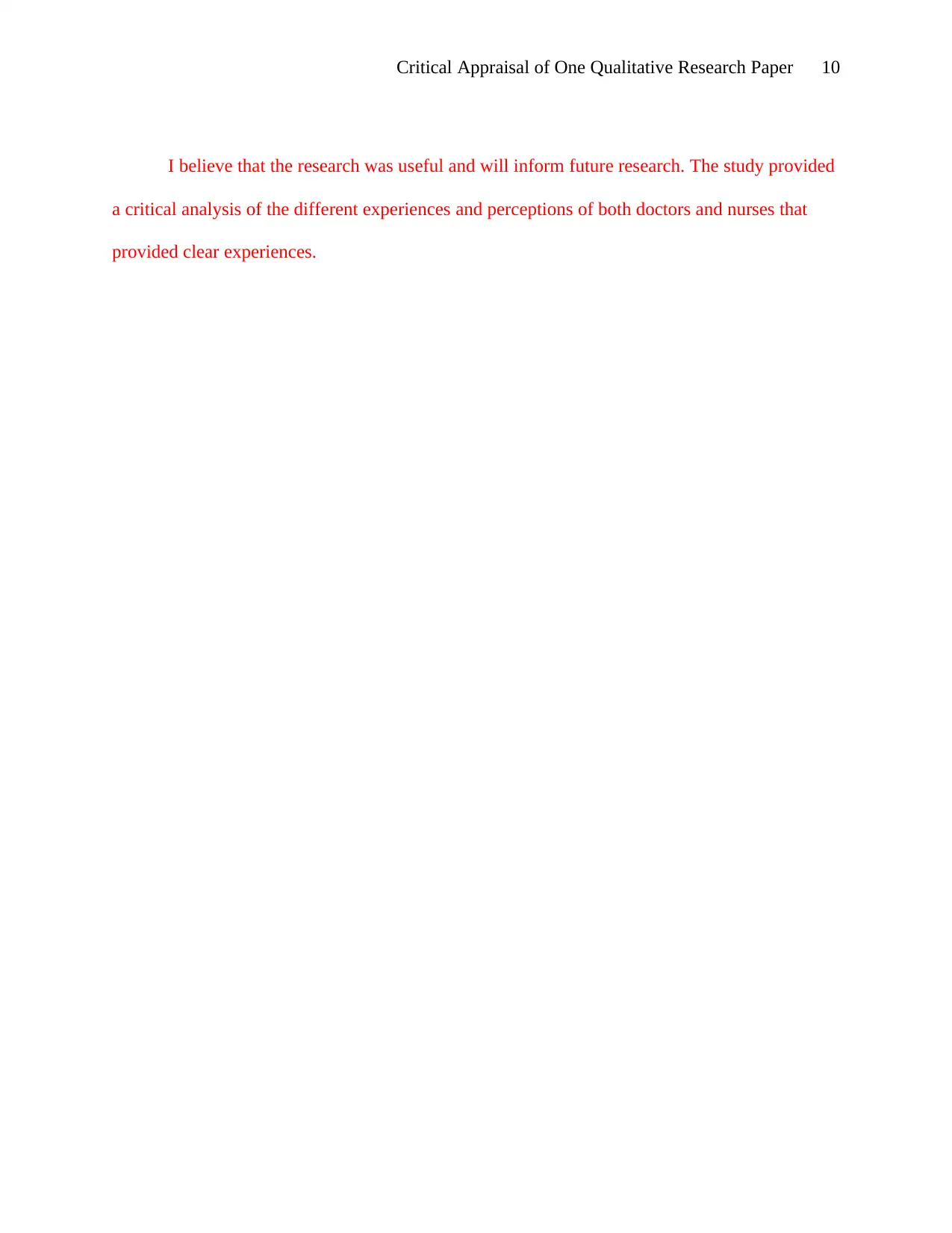
Critical Appraisal of One Qualitative Research Paper 10
I believe that the research was useful and will inform future research. The study provided
a critical analysis of the different experiences and perceptions of both doctors and nurses that
provided clear experiences.
I believe that the research was useful and will inform future research. The study provided
a critical analysis of the different experiences and perceptions of both doctors and nurses that
provided clear experiences.
Paraphrase This Document
Need a fresh take? Get an instant paraphrase of this document with our AI Paraphraser
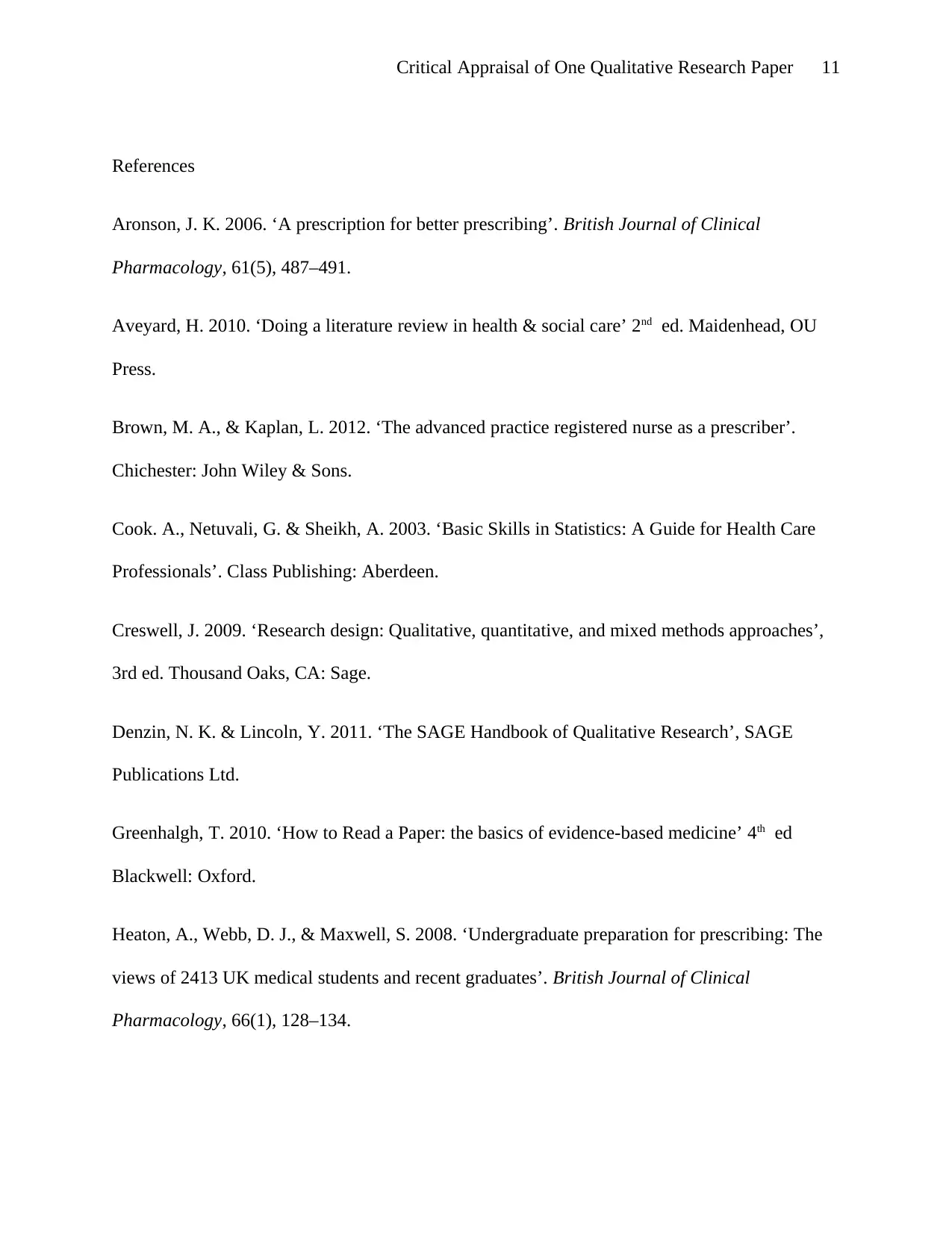
Critical Appraisal of One Qualitative Research Paper 11
References
Aronson, J. K. 2006. ‘A prescription for better prescribing’. British Journal of Clinical
Pharmacology, 61(5), 487–491.
Aveyard, H. 2010. ‘Doing a literature review in health & social care’ 2nd ed. Maidenhead, OU
Press.
Brown, M. A., & Kaplan, L. 2012. ‘The advanced practice registered nurse as a prescriber’.
Chichester: John Wiley & Sons.
Cook. A., Netuvali, G. & Sheikh, A. 2003. ‘Basic Skills in Statistics: A Guide for Health Care
Professionals’. Class Publishing: Aberdeen.
Creswell, J. 2009. ‘Research design: Qualitative, quantitative, and mixed methods approaches’,
3rd ed. Thousand Oaks, CA: Sage.
Denzin, N. K. & Lincoln, Y. 2011. ‘The SAGE Handbook of Qualitative Research’, SAGE
Publications Ltd.
Greenhalgh, T. 2010. ‘How to Read a Paper: the basics of evidence-based medicine’ 4th ed
Blackwell: Oxford.
Heaton, A., Webb, D. J., & Maxwell, S. 2008. ‘Undergraduate preparation for prescribing: The
views of 2413 UK medical students and recent graduates’. British Journal of Clinical
Pharmacology, 66(1), 128–134.
References
Aronson, J. K. 2006. ‘A prescription for better prescribing’. British Journal of Clinical
Pharmacology, 61(5), 487–491.
Aveyard, H. 2010. ‘Doing a literature review in health & social care’ 2nd ed. Maidenhead, OU
Press.
Brown, M. A., & Kaplan, L. 2012. ‘The advanced practice registered nurse as a prescriber’.
Chichester: John Wiley & Sons.
Cook. A., Netuvali, G. & Sheikh, A. 2003. ‘Basic Skills in Statistics: A Guide for Health Care
Professionals’. Class Publishing: Aberdeen.
Creswell, J. 2009. ‘Research design: Qualitative, quantitative, and mixed methods approaches’,
3rd ed. Thousand Oaks, CA: Sage.
Denzin, N. K. & Lincoln, Y. 2011. ‘The SAGE Handbook of Qualitative Research’, SAGE
Publications Ltd.
Greenhalgh, T. 2010. ‘How to Read a Paper: the basics of evidence-based medicine’ 4th ed
Blackwell: Oxford.
Heaton, A., Webb, D. J., & Maxwell, S. 2008. ‘Undergraduate preparation for prescribing: The
views of 2413 UK medical students and recent graduates’. British Journal of Clinical
Pharmacology, 66(1), 128–134.
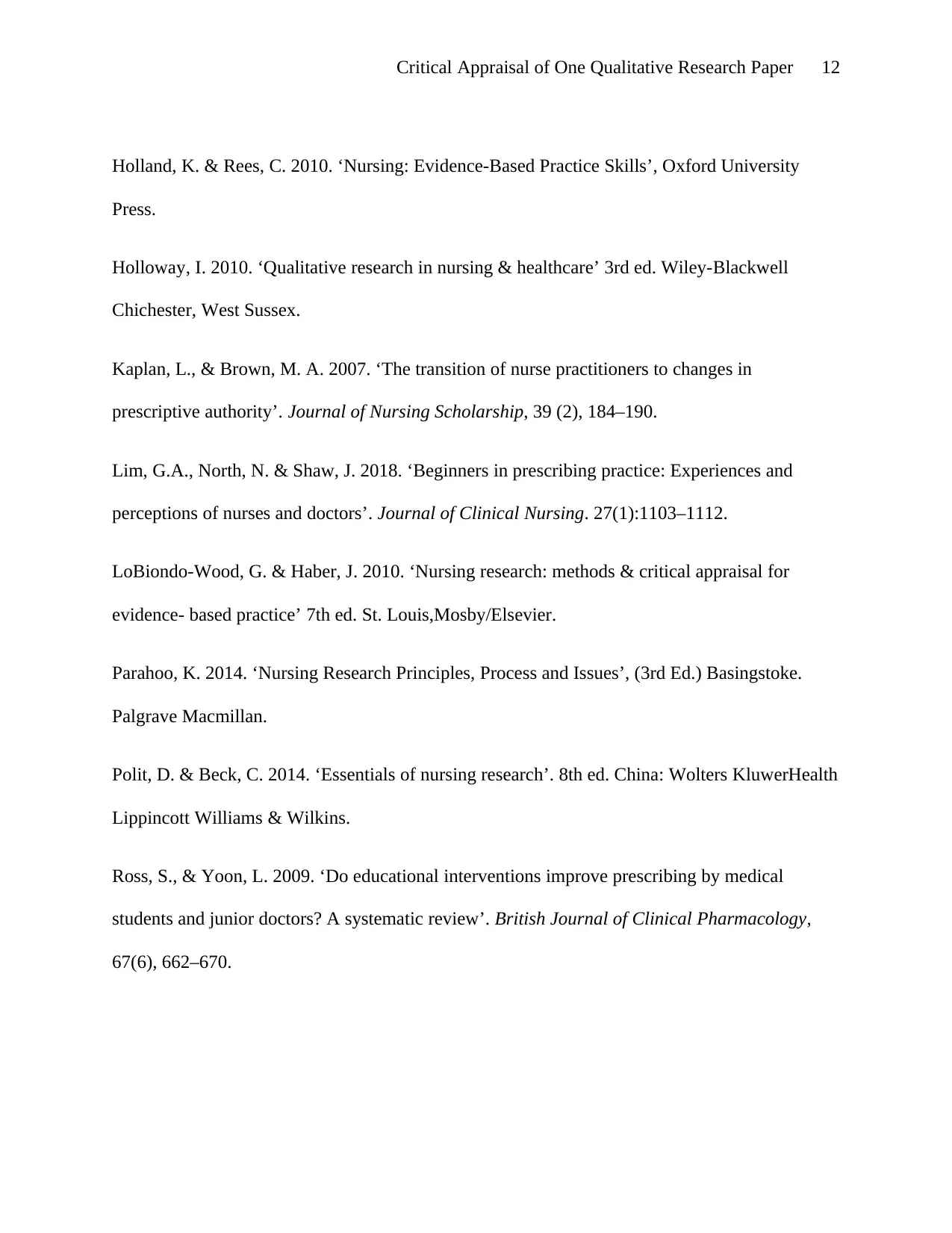
Critical Appraisal of One Qualitative Research Paper 12
Holland, K. & Rees, C. 2010. ‘Nursing: Evidence-Based Practice Skills’, Oxford University
Press.
Holloway, I. 2010. ‘Qualitative research in nursing & healthcare’ 3rd ed. Wiley-Blackwell
Chichester, West Sussex.
Kaplan, L., & Brown, M. A. 2007. ‘The transition of nurse practitioners to changes in
prescriptive authority’. Journal of Nursing Scholarship, 39 (2), 184–190.
Lim, G.A., North, N. & Shaw, J. 2018. ‘Beginners in prescribing practice: Experiences and
perceptions of nurses and doctors’. Journal of Clinical Nursing. 27(1):1103–1112.
LoBiondo-Wood, G. & Haber, J. 2010. ‘Nursing research: methods & critical appraisal for
evidence- based practice’ 7th ed. St. Louis,Mosby/Elsevier.
Parahoo, K. 2014. ‘Nursing Research Principles, Process and Issues’, (3rd Ed.) Basingstoke.
Palgrave Macmillan.
Polit, D. & Beck, C. 2014. ‘Essentials of nursing research’. 8th ed. China: Wolters KluwerHealth
Lippincott Williams & Wilkins.
Ross, S., & Yoon, L. 2009. ‘Do educational interventions improve prescribing by medical
students and junior doctors? A systematic review’. British Journal of Clinical Pharmacology,
67(6), 662–670.
Holland, K. & Rees, C. 2010. ‘Nursing: Evidence-Based Practice Skills’, Oxford University
Press.
Holloway, I. 2010. ‘Qualitative research in nursing & healthcare’ 3rd ed. Wiley-Blackwell
Chichester, West Sussex.
Kaplan, L., & Brown, M. A. 2007. ‘The transition of nurse practitioners to changes in
prescriptive authority’. Journal of Nursing Scholarship, 39 (2), 184–190.
Lim, G.A., North, N. & Shaw, J. 2018. ‘Beginners in prescribing practice: Experiences and
perceptions of nurses and doctors’. Journal of Clinical Nursing. 27(1):1103–1112.
LoBiondo-Wood, G. & Haber, J. 2010. ‘Nursing research: methods & critical appraisal for
evidence- based practice’ 7th ed. St. Louis,Mosby/Elsevier.
Parahoo, K. 2014. ‘Nursing Research Principles, Process and Issues’, (3rd Ed.) Basingstoke.
Palgrave Macmillan.
Polit, D. & Beck, C. 2014. ‘Essentials of nursing research’. 8th ed. China: Wolters KluwerHealth
Lippincott Williams & Wilkins.
Ross, S., & Yoon, L. 2009. ‘Do educational interventions improve prescribing by medical
students and junior doctors? A systematic review’. British Journal of Clinical Pharmacology,
67(6), 662–670.
⊘ This is a preview!⊘
Do you want full access?
Subscribe today to unlock all pages.

Trusted by 1+ million students worldwide
1 out of 12
Your All-in-One AI-Powered Toolkit for Academic Success.
+13062052269
info@desklib.com
Available 24*7 on WhatsApp / Email
![[object Object]](/_next/static/media/star-bottom.7253800d.svg)
Unlock your academic potential
Copyright © 2020–2025 A2Z Services. All Rights Reserved. Developed and managed by ZUCOL.
